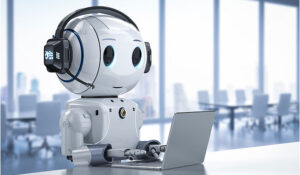Busy customers increasingly want the option to solve potential challenges without speaking to a human call agent.
Enabling this self-service capability relies on businesses tapping into customer service automation to deliver on customer demands, cut costs and boost employee satisfaction.
The Evolution of Customer Service
Customer service has always been crucial to business success, but we’ve seen it evolve and become more critical than ever in recent years.
A few short decades ago, customers were largely viewed with the business transaction in mind, with the final sale marking the end of the journey. Customers were also limited to interacting with a company during operating business hours.
However, the modern business is now obligated to engage customers on an ongoing basis, through post-sale and beyond. Bots in customer service enable organizations to interact with customers through any channel, around the clock and on any device.
Furthermore, companies are now utilizing artificial intelligence (AI) and machine learning to better understand customers’ needs and expectations, upsell and cross-sell products and enable people to solve their issues without speaking to a call agent.
This evolution in automating customer service has given the modern customer more options than ever before. So, if a brand doesn’t deliver on their expectations for immediate and personalized service, they can easily take their business to a competitor.
Defining Customer Service Automation
Customer service automation is the process of enabling customers to solve issues without having to speak to or interact with another person.
It uses software like AI-guided chatbots, interactive voice response (IVR) systems, automated emails and workflow automation to engage customers via web chat, messaging and online resources.
Automated customer service systems can deliver 24/7 customer support and, unlike human call agents, they don’t get tired, can’t be overworked and don’t need to take breaks.
As a result, automated customer service can free up human agents by taking on simple and repetitive tasks, such as resetting a password or checking an account balance and directing tickets to the most appropriate department.
This enables call agents to spend their time on more challenging issues that require human support and deliver greater business value.
How Automation Enhances Customer Experience
Customer experience automation offers a wide range of benefits, helping you to deliver on consumer demands, cut costs, enhance employee happiness and more. Customer service automation benefits include:
Positive Customer Outcomes
Arguably the biggest benefit of automation is to ensure happy customers. When a customer has a problem, they want to solve it quickly, with minimal fuss and without sitting in a long call queue.
Delivering on these expectations will keep people coming back—and happy, loyal customers are likely to spend more with their preferred brands.
Proactive Customer Support
Customer support has traditionally been a reactive service, but new technology enables you to turn it into a proactive engagement.
In addition to solving customer issues, automation can help you optimize their experience, such as sending online shoppers a message if they leave items abandoned in their cart.
Delivering on Customer Preferences
As customers increasingly prefer self-service over speaking to a human agent, offering automated support helps you deliver on their preferences.
That includes being able to talk to your business whenever they have a problem, solving issues as quickly as possible, and doing so through their preferred channel, whether via social media, web-based chatbots, phone calls or email.
Reduced Costs
Customer service costs can quickly rack up if you’re employing call agents around the clock to handle multiple channels. (Not to mention overheads like hiring, training and office space.) Automation helps you to reduce these customer service costs.
Always-on Customer Service
Customers increasingly want brands to immediately solve any issue, regardless of when and where it arises.
Automating your customer support enables you to offer 24/7 service without having to employ extra people or have them on call through the night. As a result, you can be always-on without breaking the bank.
Removing Human Error
Employing teams of agents to carry out simple, repetitive tasks increases the risk of human-made errors. Automating these tasks removes the chance of small mistakes, such as a call dropping off or speaking to the wrong call agent, that only serve to infuriate users.
Enhanced Employee Happiness
Call agents don’t want to spend their working days dealing with the same customer issues over and over. Removing these repetitive tasks enables people to work on more stimulating challenges, which increases the chances of them enjoying their role. And happy employees are more likely to offer better support, which means more satisfied customers.
Is There a Downside to Automating Customer Service?
Despite these positives, there are some drawbacks to automating your entire customer service offering. For example:
Lack of Human Touch
Automating all customer interaction can run the risk of alienating people if there’s no human touch. Some people still want the option to speak to a human, and there are some issues a chatbot can’t solve. So, it’s vital to include the opportunity for an AI solution to pass a customer onto a call agent.
Customer Confusion
If you’re going to utilize automated customer service, it’s crucial to make the process as straightforward as possible.
For example, an IVR menu with convoluted options could leave a customer confused about which one to choose, causing them to hang up the phone and turn to a competitor.
Additionally, a poorly designed system could result in customers being passed back and forth between AI chatbots and product FAQ sites, which will only frustrate them.
Learn How to Streamline Your Customer Service Process With Automation
With that in mind, it’s crucial to understand how to design and streamline your automated customer service process.
Understanding Pain Points and Customer Service Challenges
The first step in ensuring your automated process works smoothly is to understand the kinds of problems your customers face.
Assess the most common issues customers call about, such as changing their account details, getting a refund or understanding how to use a product, and shape your process toward those customer service challenges.
Identifying Opportunities for Automation
Understanding customer challenges lets you determine which issues can easily be supported by chatbots and ensure your system helps customers solve problems quickly.
It also allows you to identify more complex cases, such as customer complaints, that may require interaction with a human call agent.
Setting Goals and Expectations
With customer challenges understood, you can begin setting goals and expectations for the customer service automation process.
Once implemented, keep an eye on the system to ensure there are no bottlenecks in the support process and it’s helping customers solve their challenges quicker than through your call agents.
Evaluating Different Automation Solutions
Going ahead and implementing any automation solution runs the risk of it struggling to fulfill your goals and expectations. Take the time to assess the market to find a solution that best suits your customers’ needs and complements your existing technology stack.
Best Practices for Successful Customer Service Automation
Before going ahead and implementing a solution, you need to implement an objection handling framework and ensure the technology delivers what your customers need and saves you time and money. Automating customer service best practices include:
Implement User-Friendly Self-Service Portals
Delivering on customers’ self-service expectations relies on the technology being easy to use and menus being clear and well designed.
You need to take time to design your portals to be user friendly and create selection options that are simple to understand.
Craft Effective Automated Responses
Creating automated responses can help you to immediately solve customer challenges. For example, if 90% of customers contact you to check their available account balance, consider a menu option of “Press 1 for account balance” or a brief automated guide that eliminates the need for call agents or a chatbot. This will boost customer satisfaction as they can rapidly solve their issue with minimal fuss.
Balance Automation With Human Interaction
Going all-in on customer service automation may not be a smart choice for every company. Start out by automating some tasks while offering the option for human interaction when customers need it. Some people will still want to speak to a call agent, so eliminating that option may end up pushing them away.
Train Customer Services Reps for Hybrid Support
It’s also vital to ensure all employees are on board with automation and understand the situation. AI technology like chatbots isn’t replacing human workers, but rather taking tedious tasks away from people and enabling them to work on more challenging jobs.
But it’s essential to ensure your employees recognize this fact and, moreover, understand how the hybrid approach works.
The Best Automated Customer Service Tools
Perfecting your customer service automation process relies on using the best tools in the market. For example, conversational AI is crucial to helping your chatbots better understand human language, and an IVR tool is vital to taking repetitive tasks off your call agents’ hands.
Additionally, robotic process automation is instrumental in automating reproducible tasks and transforming customer service and contact centre processes.
Author: Guest Author
Published On: 21st Aug 2023 - Last modified: 9th Dec 2024
Read more about - Guest Blogs, Uniphore















